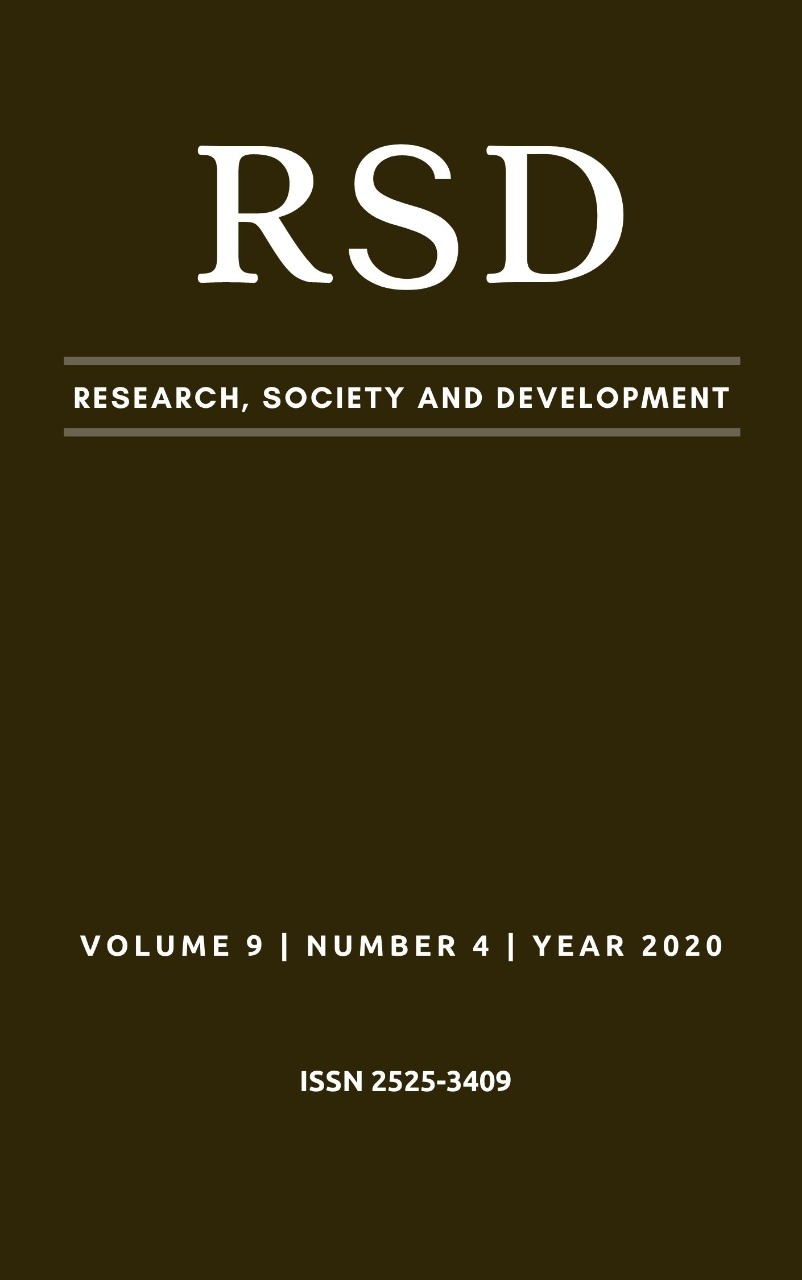Efeitos do toque terapêutico no cuidado integral ao ser humano à luz do Pensamento Ecossistêmico
DOI:
https://doi.org/10.33448/rsd-v9i4.2421Palavras-chave:
Cuidados de Enfermagem, Toque Terapêutico, Terapias Complementares, Enfermagem, Tecnologias em Saúde, Ecossistema.Resumo
Objetivo: Analisar o toque terapêutico no cuidado integral ao ser humano à luz do Pensamento Ecossistêmico, na visão do enfermeiro. Método: Estudo exploratório, descritivo, qualitativo, realizado com 11 enfermeiros, que utilizaram o Toque Terapêutico no cotidiano do trabalho profissional em diferentes cenários de saúde, selecionados pela técnica Snowball. Os dados foram coletados, por meio de entrevista semiestruturada e submetidos à Análise Textual Discursiva. Resultados: A análise dos dados permitiu constatar que a aplicação do Toque Terapêutico inte-relacionado aos princípios do Pensamento Ecossistêmico, possibilita cuidar do ser humano na sua integralidade. Os elementos participantes dessa tecnologia, compreendidos como um sistema e respectivos subsistemas, formam uma totalidade/unidade ecossistêmica, que em contínua inter-relação entre si e com o campo energético universal, produzem movimento e energia. Esse conjunto busca harmonizar e equilibrar o campo energético do ser humano, envolvendo suas multidimensionalidades bio-psico-sociais e espirituais como um todo. Conclusão: Existe a possiblidade, ao aplicar o Toque Terapêutico, utilizando princípios ecossistêmicos, de propiciar efeitos do cuidado integral ao ser humano e entendê-lo como um sistema, que em continua mudança, promovida pelas inter-relações dos seus componentes e com o ambiente, no qual vive e se desenvolve.
Referências
Arrieira, I.C.O. et al. (2018). Spirituality in palliative care: experiences of an interdisciplinary team. Rev Esc Enferm USP, 12;52:e03312. doi: http://dx.doi.org/10.1590/S1980-220X2017007403312
Brasil (2012). Ministério da Saúde. Conselho Nacional de Saúde. Comissão Nacional de Ética em Pesquisa. Resolução nº 466 de 12 de dezembro de 2012: diretrizes e normas regulamentadoras de pesquisa envolvendo seres humanos. Brasília (DF): MS; 2012.
Delaney, C. et al. (2018). Trends in Contemporary Holistic Nursing Research. Journal of Holistic Nursing, 36(4):385-94. doi: https://doi.org/10.1177/0898010117750451
Goodman, L. (1961). Snowball Sampling. In: Annals of Mathematical Statiscs, v. 32, p.148-170.
Hanley, M.A., Coppa, D. & Shields, D. (2017). A Practice-Based Theory of HealingThrough Therapeutic Touch: Advancing Holistic Nursing Practice. Journal of Holistic Nursing, 35(4): 369–81. doi: https://doi.org/10.1177/0898010117721827
Júnior, E.T. (2016). Práticas integrativas e complementares em saúde, uma nova eficácia para o SUS. Estudos Avançados, 30(86):99-112. doi: https://dx.doi.org/10.1590/S0103-40142016.00100007
Kramer, D. (2018). Energetic Modalities as a Self-Care Technique to Reduce Stress in Nursing Students. Journal of Holistic Nursing, 36(4): 366-73. doi: https://doi.org/10.1177/0898010117745436
Krieger, D. (1995). O Toque Terapêutico: Versão Moderna da Antiga Técnica de Imposição de Mãos. São Paulo: Cultrix.
Marta, I.E.R. et al. (2010). The effectiveness of Therapeutic Touch on pain, depression and sleep in patients with chronic pain: clinical trial. Rev Esc Enferm USP, 44(4):1100-6. doi: http://dx.doi.org/10.1590/S0080-62342010000400035
Medeiros, A.C. et al. (2016). Comprehensiveness and humanization of nursing care management in the Intensive Care Unit. Rev Esc Enferm USP, 50(5):816-22. doi: http://dx.doi.org/10.1590/S0080-623420160000600015
Medeiros, S.P. (2019). Perception of Nursing Undergraduate Student About Receiving the Therapeutic Touch. Rev Fund Care Online, 11:e- 464-69. doi: http://dx.doi.org/10.9789/2175- 5361.2019.v11i2.464-469
Mello, T.C.A. & Brito, R.S. (2015). Efetividade do toque terapêutico no alívio de sintomatologia do paciente. Rev Saúde UFSM, 41(2): 45-52. doi: http://dx.doi.org/10.5902/2236583414472
Motta, P.M.R. & Barros, N.F. (2015). The application of the trchnique of imposition of hands on stress-anxiety: a systematic literature review. Cad Ter Ocup UFSCar, 23(2):381-92. doi: http://dx.doi.org/10.4322/0104-4931.ctoAR0534
Moraes, R. & Galiazzi, M.C. (2016). Análise textual discursiva.3. ed. Revisada e Ampliada. Ijuí: Editora Unijuí.
O’Mathúna, D.P. (2016). Therapeutic touch for healing acute wounds. Cochrane Database Syst Rev, 3(5):CD002766. doi: https://doi.org/10.1002/14651858.CD002766.pub4
Ramada, N.C., Almeida, F.A. & Cunha, M.L. (2013). Therapeutic touch: influence on vital signs of newborns. Einstein, 11(4):421-5. doi: http://dx.doi.org/10.1590/S1679-45082013000400003
Rangel, R.F. et al. (2017). Comprehensive care: meanings for teachers and nursing students. Rev Rene, 18(1):43-50. doi: https://doi.org/10.15253/2175-6783.2017000100007
Santos, D.S. et al. (2013). Using an experimental model for the study of therapeutic touch. Rev Latino Am Enfermagem, 21(1):442-9. doi: http://dx.doi.org/10.1590/S0104-11692013000100021
Santos, C.T.B. et al. (2018). Integrality in Brazil and Venezuela: similarities and complementarities. Ciênc Saúde Coletiva, 23(4):1233-40. doi: https://doi.org/10.1590/1413-81232018234.16122016
Siqueira, H.C.H. et al. (2018). Health of human being in the ecosystem perspective. J Nurs UFPE on line, 01;12(2):559-64. doi: https://doi.org/10.5205/1981-8963-v12i2a25069p559-564-2018
Siqueira, H.C.H. et al. (2019). Support networks to user with chronic kidney disease in the ecosystemic perspective. Rev Min Enferm, 23:e-1169. doi: http://www.dx.doi.org/10.5935/1415-2762.20190017
Sousa, R.M. & Guimarães, C.M. (2014). Aplicação do Toque Terapêutico na Assistência Complementar em Enfermagem. Estudos, 41:e-151-63. doi: http://dx.doi.org/10.18224/est.v41i0.3815
Tabatabaee, A. et al. (2016). Effect of Therapeutic Touch in Patients with Cancer: a Literature Review. Med Arch, 70(2): 142–47. doi: 10.5455/medarh.2016.70.142-147
Zamberlan, C. et al. (2018). Guidance for children of fathers/mothers with heart disease: possibilities and approaches.Rev Enferm UERJ, 26:e28057. doi: http://dx.doi.org/10.12957/reuerj.2018.28057
Vanaki, Z. et al. (2016). Therapeutic touch for nausea in breast cancer patients receiving chemotherapy: Composing a treatment. Complement Ther Clin Pract, 22:64-8. doi: https://doi.org/10.1016/j.ctcp.2015.12.004
Downloads
Publicado
Edição
Seção
Licença
Autores que publicam nesta revista concordam com os seguintes termos:
1) Autores mantém os direitos autorais e concedem à revista o direito de primeira publicação, com o trabalho simultaneamente licenciado sob a Licença Creative Commons Attribution que permite o compartilhamento do trabalho com reconhecimento da autoria e publicação inicial nesta revista.
2) Autores têm autorização para assumir contratos adicionais separadamente, para distribuição não-exclusiva da versão do trabalho publicada nesta revista (ex.: publicar em repositório institucional ou como capítulo de livro), com reconhecimento de autoria e publicação inicial nesta revista.
3) Autores têm permissão e são estimulados a publicar e distribuir seu trabalho online (ex.: em repositórios institucionais ou na sua página pessoal) a qualquer ponto antes ou durante o processo editorial, já que isso pode gerar alterações produtivas, bem como aumentar o impacto e a citação do trabalho publicado.


